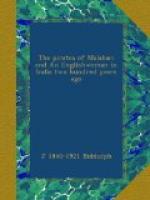When the intelligence of Kidd’s piracies reached England, there was a storm of indignation in the country. Party feeling was running high and with unusual violence. The majority in the House of Commons desired the ruin of Somers and Orford while aiming at the King. The charge of abetment in Kidd’s misdeeds was too useful a weapon to be neglected, so it was added to the list of accusations against them. It must be admitted that the circumstances of the Lord Chancellor, the head of the Admiralty, and other prominent men using their influence to forward a venture from which they were to profit, under fictitious names, and that had created such a scandal, demanded inquiry. It was hardly sufficient to say that they had lost their money. Such an answer would justify any illegal enterprise in the event of its failure.
The French war had come to an end, so in January, 1699, a royal squadron of four men-of-war, the Anglesea, Harwich, Hastings, and Lizard, sailed from Portsmouth for Madagascar under Warren.[3] They carried with them four royal commissioners and a proclamation offering a free pardon, from which Every and Kidd were excepted, to all pirates who voluntarily surrendered themselves before the end of April, 1699. The pardon related only to acts of piracy committed east of the Cape of Good Hope, between the African and Indian coasts. After calling at St. Augustine’s bay, where several pirates made their submission, the squadron reached Tellicherry in November. As it came to its anchorage, Warren died, and was buried on shore the following day. He was succeeded in the command by Littleton. In the following May, Littleton was on the Madagascar coast, where he remained till the end of the year before returning home. During the whole time he was in communication with the pirates. His dealings with them brought him into disrepute in shipping circles. Hamilton tells us that “for some valuable reasons he let them go again; and because they found a difficulty in cleaning the bottoms of their large ships, he generously assisted them with large blocks and tackle falls for careening them.” Possibly Hamilton’s remark was due to the conduct of Captain White of the Hastings, whose behaviour excited such suspicion that Littleton placed him under arrest, fearing he would make his ship over to the pirates. Littleton remained on the Madagascar coast for eight months without firing a shot. When he first reached St. Mary’s, the pirates greeted him with a salute of nine guns,




